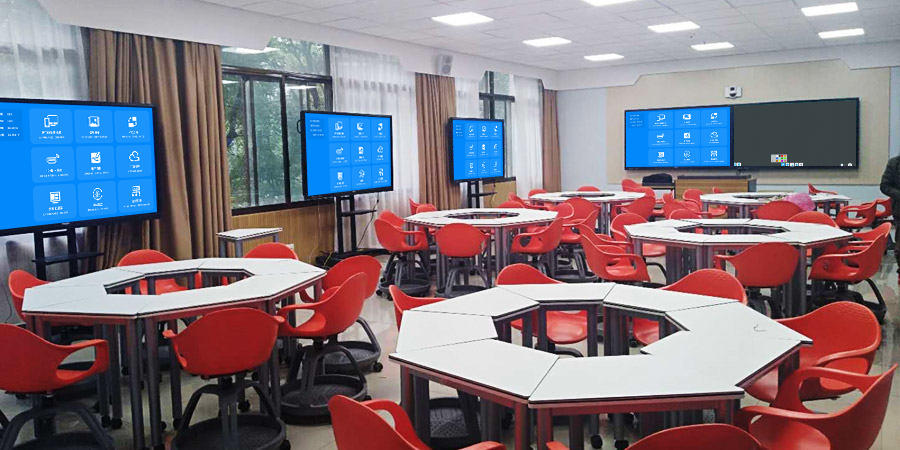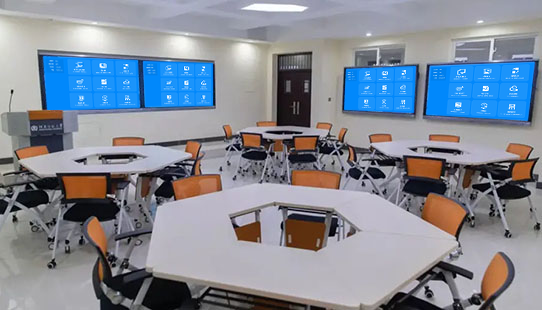Smart Classrooms: An Innovative Solution for Building a New Educational Ecosystem
As the education sector accelerates its digital transformation, the smart classroom has evolved from a conceptual idea into a critical practice for reshaping the teaching experience and improving education quality. By leveraging advanced information technology, it breaks the time and space limitations of traditional teaching, creating a modern learning environment that is highly interactive, rich in resources, and intelligently managed. This brings an unprecedented teaching and learning experience to both teachers and students.
I. Analyzing the Core Needs of Smart Classrooms
With evolving educational philosophies and technological advancements, modern smart classrooms must meet several core needs:
- Fostering Diverse Interactions: Moving away from the traditional teacher-centric lecture, smart classrooms introduce a variety of interactive formats, such as group discussions, real-time feedback, and peer reviews. This encourages students to actively participate in class, transforming them from passive recipients of knowledge into active explorers. The goal is to cultivate critical thinking and teamwork skills.
- Seamless Resource Integration: Enabling the smooth flow and sharing of various educational resources—like courseware, videos, and online learning platforms—across different devices. Simultaneously, the system must automatically collect, store, and analyze data generated from classroom interactions to provide strong data support for precision teaching and personalized tutoring.
- Simple and Stable Operation: The educational equipment should be simple and intuitive to use, requiring minimal training for both teachers and students to get started. This ensures that the teaching process is not disrupted by technical issues. The system must also be highly stable, reliably running even during long-term use and in complex scenarios with many concurrent devices.
- Broad Compatibility and Adaptation: Devices in a smart classroom must be compatible with different brands and models of computers, tablets, and phones, as well as mainstream educational software and applications. This flexibility accommodates diverse teaching needs and user habits.

II. Innovative Technology Powers Smart Classrooms
To meet these demanding needs, a series of cutting-edge technologies are deeply integrated into the smart classroom solution:
- Multi-Protocol Wireless Screen Mirroring: This technology is fully compatible with AirPlay, Miracast, WiDi, DLNA, Google Cast, and proprietary protocols, covering all operating systems, including iOS, Android, Windows, macOS, and HarmonyOS. A teacher can use a MacBook to display courseware, and students can submit homework via an Android tablet, all with a single click. The transmission latency is as low as 80ms, ensuring smooth visuals and synchronized audio, so teaching presentations are never interrupted by lag.
- Multi-Screen Collaborative Interaction: This solution creates a “main screen + group screens” collaborative model. The teacher on the main screen can monitor discussions on all group screens in real-time and push important materials or explanations to specific groups with a single click. Group discussion results can also be easily pushed to the main screen for whole-class sharing. With a built-in interactive whiteboard and annotation features, teachers can directly annotate and explain a student’s mirrored homework or proposal, fostering deep interaction and the exchange of ideas between teachers and students, and among students themselves.
- Minimalist Operation and Smart Anti-Interference Design: Adhering to a minimalist design philosophy, teachers can quickly mirror their screens by simply scanning a QR code or entering a 6-digit code with their phone, eliminating the need for complex setup and pairing. The device features dual-band Wi-Fi and a smart anti-interference chip. Even in a classroom with many devices connected simultaneously and a complex network environment, it maintains a stable signal transmission, ensuring continuous and reliable mirroring.
- Integrated Hardware and Software for Data Consolidation: The smart classroom solution not only connects hardware devices but also uses a配套 software platform to automatically record class content (supporting RTSP protocol for integration with existing school recording systems). Student interaction annotations and answer data are uploaded to the platform in real-time. The platform performs a deep analysis of this data, generating visualized reports such as a “classroom interaction heatmap” and a “knowledge mastery report,” which helps teachers accurately understand teaching effectiveness and provides a scientific basis for adjusting future teaching strategies.
III. Smart Classroom Applications in Diverse Scenarios
- Routine Teaching Scenarios: Using a BYOD (Bring Your Own Device) model, teachers and students can wirelessly mirror teaching materials and learning outcomes from their personal devices to the large classroom screen anytime. In an English class, a teacher can mirror a clip from an English movie from their phone for a listening exercise, and students can complete an online test on a tablet and mirror their answers. This significantly boosts class participation and creates a more active teaching atmosphere.
- Group Discussion Scenarios: Using the multi-screen interaction feature, each group is equipped with a separate group screen. Group members can mirror their ideas and materials to their screen for collaborative discussion. The teacher on the main screen can clearly see the progress of each group and provide timely guidance. For example, in a physics lab class, each group can mirror its experimental data and analysis, and students can compare and discuss among groups, promoting a deeper understanding and application of knowledge.
- Remote Teaching Scenarios: With powerful network technology and device compatibility, high-quality educational resources can be shared in real-time. Students in remote areas can access the smart classroom system through their devices and “sync” with a famous urban teacher, participating in class interactions and Q&A sessions. This breaks geographical limitations and promotes educational equity.

IV. Real-World Results Prove the Value
Many universities and educational institutions have actively adopted the smart classroom solution and achieved significant results:
- National University of Defense Technology: Systematically modernized over 120 traditional classrooms, including hardware upgrades, optimization of existing teaching software platforms, custom software development, and in-depth hardware and software compatibility debugging. The renovated classrooms include tiered multimedia classrooms, flat smart classrooms, multi-window interactive classrooms, and discussion-based classrooms, which have greatly enhanced the level of intelligence in the teaching environment and provided a more efficient and convenient learning space for teachers and students.
- Beijing Normal University: Built 130 smart classrooms. Using the solution’s interactive features and data consolidation mechanism, teachers can now accurately track students’ learning status and knowledge mastery, precisely adjusting their teaching pace and content. This has led to a significant improvement in teaching quality and ensured effective learning outcomes for students.
- Nanjing University of Aeronautics and Astronautics: Deployed a smart screen mirroring solution in over 600 classrooms, enabling the quick sharing of teaching resources and high-efficiency interaction. This has fully stimulated students’ interest and initiative, making the classroom atmosphere much more lively and earning widespread recognition from both teachers and students.
The smart classroom solution remains fundamentally committed to “serving the essence of teaching.” With advanced technology, comprehensive features, and rich application scenarios, it helps educational institutions make a seamless transition from traditional to smart teaching models. Choosing this solution means starting a new chapter in smart education with low cost and high efficiency, laying a solid foundation for cultivating innovative talent that is prepared for the future.